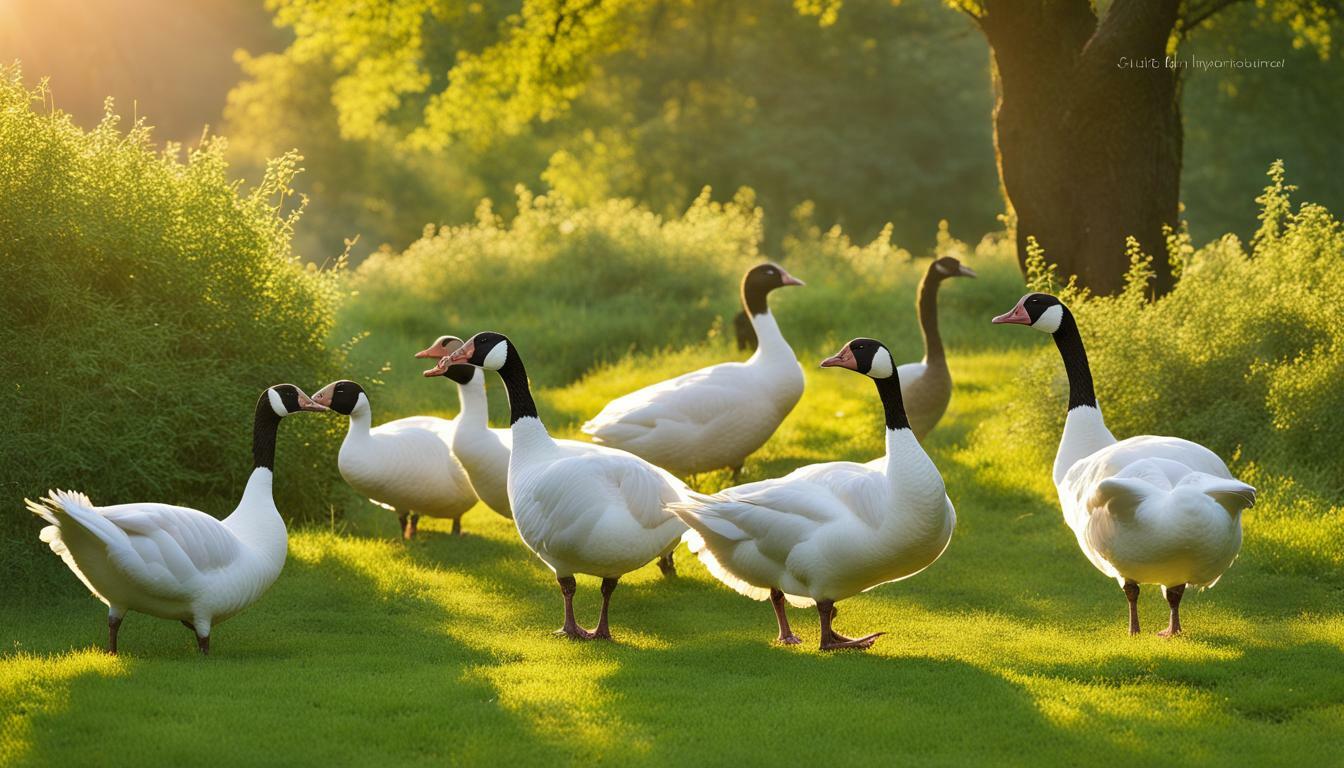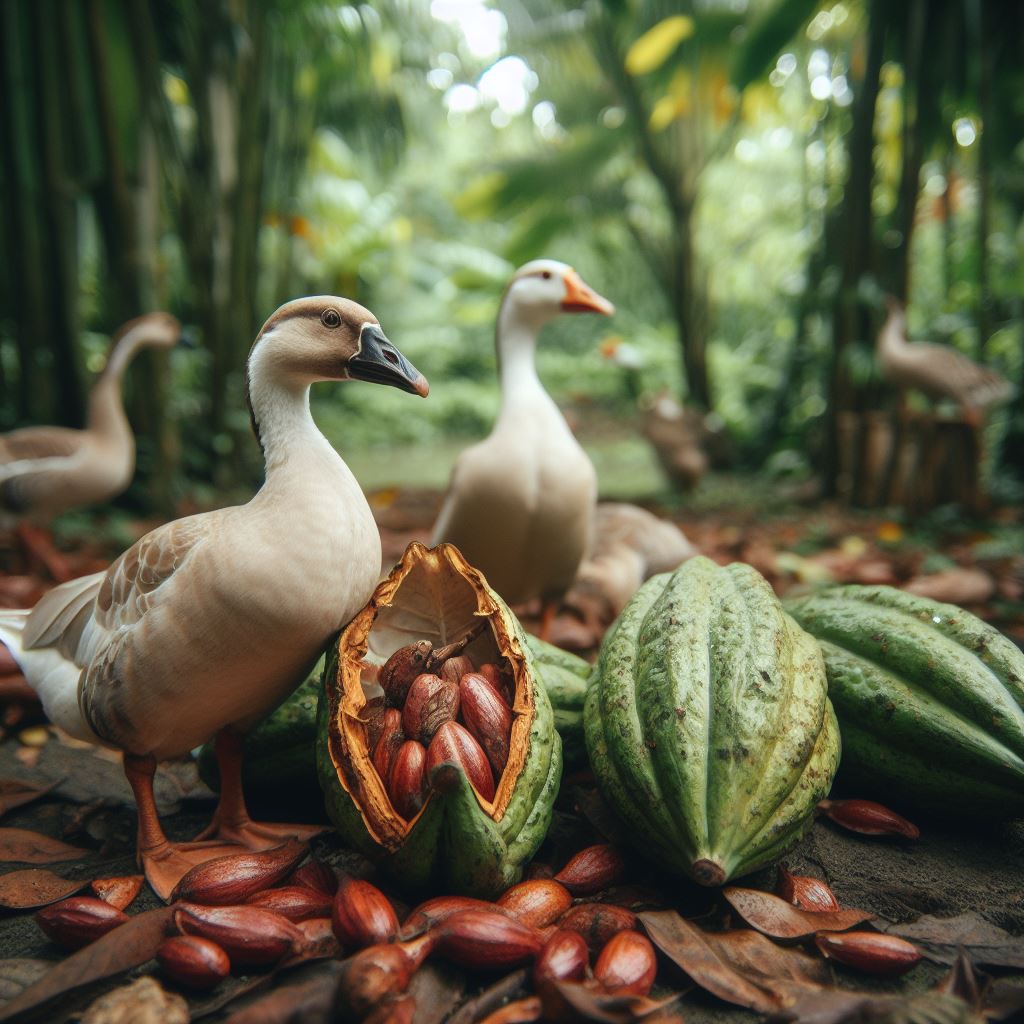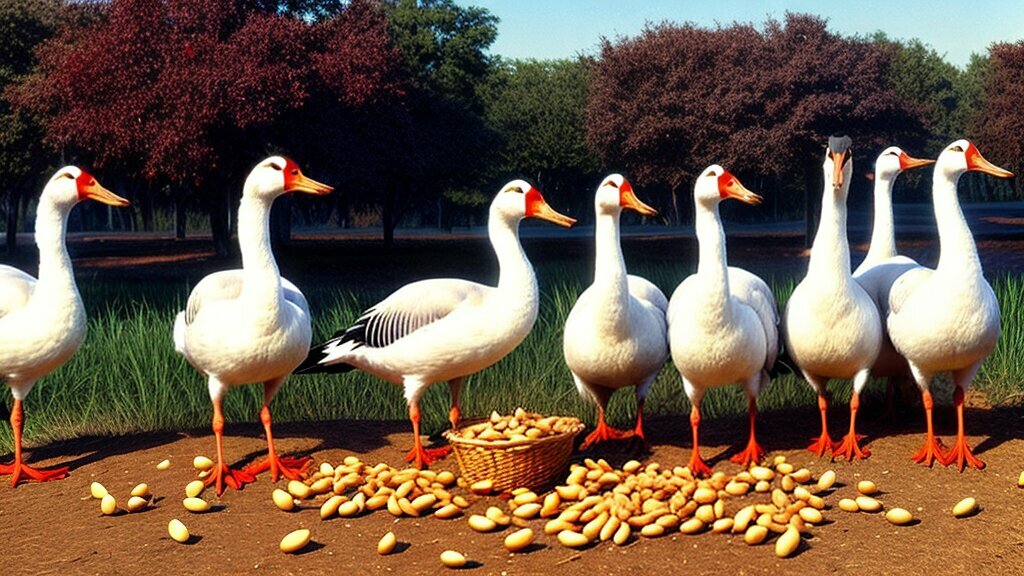Why Do Geese Have Long Necks? Unraveling Avian Mysteries

Table of content:
- Evolutionary Adaptation
- Reaching Food Sources
- Underwater Foraging
- Reaching Up High
- Anatomy Allows Extreme Flexibility
- Aerodynamic Advantages
- Esophagus Length
- Differences Between Geese Species
- Development in Goslings
- Why Other Birds Don’t Have Long Necks
- Unique Respiratory Adaptations
- Staying Safe From Predators
- Impressive Flexibility on Display
- Why Not Even Longer?
- Unique Among Birds
- Long Necks Can Be a Hassle
- Why Geese Hold Their Necks in an S Shape
- Neck Length Differences Between Males and Females
- Don’t Underestimate the Neck
- Final Thoughts
Geese are beautiful waterfowl known for their iconic V-shaped flying formation. But one of their most distinguishing features is their exceptionally long necks.
Have you ever wondered why geese evolved to have such lengthy necks compared to other birds? Their unique anatomy serves some important purposes that aid geese in survival.
Evolutionary Adaptation
Geese belong to the family Anatidae, which includes ducks, swans, and other waterfowl species. But even compared to their close relatives, geese tend to have the longest necks proportional to their body size.
This is due to evolutionary adaptations that occurred over many generations. Birds with longer necks had an advantage in finding food and surviving to pass on their genes. So natural selection favored geese with the longest necks.
Over time, anatomical changes to the trachea and vertebrae allowed geese necks to become exceptionally elongated. Now, most geese species sport long, flexible necks that makeup 1/3 or more of their total body length.
Reaching Food Sources
So why did having a long neck become so advantageous for geese? The main reason is that it allows them to feed more efficiently.
Geese spend much of their time foraging for food while walking or swimming. A long neck lets a goose reach vegetation that’s deeper underwater or farther away from the shore.
Their flexible neck also lets them dig through mud and sediment while keeping their body above the surface. They can grasp shoots, seeds, roots, and invertebrates from taller grass and vegetation that other animals can’t reach.
With their expansive range, geese can find food other birds simply can’t access. This gives them an edge in habitats where food is scarce or competition is high.
Underwater Foraging
A goose’s elongated neck is especially beneficial when they are foraging underwater.
Geese have waterproof feathers that allow them to submerge their entire body when searching for aquatic plants, fish, and invertebrates. Their long neck lets them dive deeper to access food sources other birds can’t reach.
Their neck contains vertebrae that are both long and highly flexible, allowing the neck to bend and extend. Geese can move their neck independently of their body, letting them forage while keeping their vision above water.
Being able to access these underwater food sources gives geese a safe and plentiful food supply. And it reduces competition with other species for resources.
Reaching Up High
While water access is a goose’s primary habitat, they also spend time grazing on land. Here too, their long necks provide a distinct feeding advantage.
A goose’s neck allows it to reach up higher into trees, bushes, and tall grass. While ducks are limited to plants close to the ground, geese can access fruits, seeds, shoots, and leaves much farther up.
This vertical range means they have more options in environments with limited ground vegetation. Their flexible neck allows them to comfortably forage even at full extension upwards.
Geese take advantage of their sporty reach to grab berries from shrubs, strip leaves from tree branches, and pluck seeds from the tops of grasses. Expanding their grazing height gives them a lot more opportunities to find food.
Anatomy Allows Extreme Flexibility
Geese have several unique anatomical adaptations that allow their necks to extend so far vertically and horizontally:
- Extra cervical vertebrae – Geese have a highly flexible neck made up of 13-17 cervical vertebrae. Similar birds have only 9-15. More vertebrae increase range of motion.
- Longer vertebrae – Each individual neck vertebra in geese is elongated, adding to overall neck length.
- Special joints – The vertebrae connect with ball and socket joints for greater flexibility compared to other birds. This allows them to bend their neck into S-shapes.
- Stretchy ligaments – The vertebrae are connected with elastic ligaments that stretch as the neck extends. This helps provide a wide range of motion.
- Blood vessel network – Geese have an extensive network of blood vessels in their neck to supply oxygen when fully extended.
- Air sacs – Special air sacs in the neck provide an oxygen reserve when the trachea is stretched out during feeding. This enables longer periods underwater.
These adaptations allow a goose’s slender neck to stretch, bend, and flex into positions other animals simply can’t achieve. Their remarkable flexibility aids their ability to find food.
Aerodynamic Advantages
A goose’s long neck doesn’t just help them while eating – it also provides aerodynamic advantages in flight.
Geese fly long migrations in their V-shaped flocks. Their neck helps adjust their center of gravity and steering in flight. When stretched straight, it moves their point of balance forward for better stability.
Their neck also acts as a rudder to steer and maneuver in the air. By bending their flexible neck, geese can finely tune their course for smooth migration flights.
Their elongated neck also lets them keep a lookout during flight. With excellent vision, geese can scan for food sources or safe landing spots from higher elevations.
Esophagus Length
One might assume a long neck requires an equally long esophagus to swallow food. But in geese, this isn’t the case.
Unlike their trachea which runs the length of the neck, a goose’s esophagus takes a more direct route. It runs from the throat straight down into the body cavity.
From there, the waterfowl’s digestive system finishes the process of swallowing food. This shorter path means geese don’t have issues swallowing, despite their long reach when feeding.
The length of a goose’s neck doesn’t correlate to the length of its esophagus. Their branched trachea is specially adapted for neck extension, while the esophagus takes a shortcut.
Differences Between Geese Species
While all geese have elongated necks compared to other birds, some species have noticeably longer necks than others. The longest neck to body ratios are found in:
- Emperor Geese
- Bar-headed Geese
- Snow Geese
- Ross’s Geese
- White-fronted Geese
Conversely, the following domestic and wild geese tend to have somewhat shorter necks:
- Pilgrim Geese
- African Geese
- Canada Geese
- Red-breasted Geese
Regardless of species, a goose’s neck will be disproportionately long compared to similar waterfowl. But neck length varies depending on adaptation to their feeding environment over generations.
Development in Goslings
At birth, goose goslings already have a prominent long neck, but it is still disproportionately small compared to adults.
Over the first few months, gosling necks lengthen rapidly as they mature. Their vertebrae and tracheal anatomy adapt to allow this extended growth.
The neck lengthening supports the increased foraging capability they need for survival as they transition away from parental care.
By approximately 3-4 months of age, goslings reach full adult size and neck proportions. Their neck anatomy matures to provide the foraging benefits that give geese an evolutionary advantage.
Why Other Birds Don’t Have Long Necks
Geese aren’t the only avians with long necks – birds like herons, cranes, pelicans, and swans also have elongated necks.
But in other aquatic bird groups, necks tend to be much shorter, including:
- Ducks
- Loons
- Grebes
- Rails
- Penguins
There are a few reasons these birds evolved with shortened necks compared to geese:
- Smaller body size reduces need for extended reach
- Use alternative foraging strategies like diving instead of reaching
- Differences in trachea structure and flexibility
- Distinct family traits passed on over generations
- Varied habitat and food sources with less benefit from a long neck
So why do geese have such long necks compared to their close duck relatives? They evolved under environmental conditions that favored maximum extension for exploiting food resources.
Over time, geese were naturally selected for longer vertebrae and more flexible joint structures. This gave them an advantage in finding sustenance compared to short-necked species.
Unique Respiratory Adaptations
A goose’s trachea also has special anatomical adaptations that allow its remarkable neck extension:
- Long trachea – The windpipe spans the entire length of the neck, extending up to 1.5 meters in large geese.
- Flat rings – The tracheal rings are flat and flexible compared to rigid rings in mammals. This increases bendability.
- Extra rings – Geese have 120-150 tracheal rings compared to about 50 in humans. More rings increase flexibility without collapsing.
- Carinate ridges – Spiral ridges inside the trachea help keep it open when fully extended during feeding.
- Branching – The lower trachea branches into two tubes within the body that can slide and elongate independently.
- Large volume – The trachea has a very wide diameter, increasing air volume exchange for underwater breathing.
These adaptations allow geese to stretch their trachea into a lengthy tube without losing airway stability. Even fully extended, they can continue breathing during feeding.
Staying Safe From Predators
An elongated neck also aids geese when they are alert and wary.
From water or land, geese can raise their head high above obstructions to watch for potential predators. Their excellent vision lets them spot threats from farther away compared to short-necked birds.
If danger approaches, they are able to let out loud warning honks to signal others while keeping their body low and protected. A long neck provides increased reaction time to danger.
Frequently standing tall gives geese better environmental awareness. Their flexible neck allows them to quickly tuck in their head and flee if needed.
Impressive Flexibility on Display
A goose’s ability to extend its long neck is visually on display during behaviors like:
- Reaching for high seeds or fruits at full stretch upwards
- Plunging their neck underwater to forage while their feet remain on shore
- Bending into S-shaped curves to preen feathers along their back
- Flapping neck up and down during territorial or courtship displays
- Using neck as a rudder to steer while flying in a tight V-formation
- Rotating neck 270 degrees or more to scan surroundings for potential threats
Their remarkable flexibility helps showcase exactly why geese evolved such prominent elongated necks compared to other birds.
Why Not Even Longer?
Geese have impressively lengthy necks, frequently greater than 1/3 of their full height. But there are evolutionary constraints that prevent their necks from being even longer.
Some of the limitations include:
- Body mass – Excessively long necks become heavy and make takeoffs difficult. Longer necks require larger body sizes for balance.
- Energy use – Extending the neck frequently requires extra energy expenditure. Too long of a neck requires greater calories.
- Mortality – Goose goslings with mutations causing overly long necks may suffer higher mortality from vulnerability.
- Mating success – Necks too out of proportion may result in mating disadvantage. Natural selection favors moderate neck length.
- Nesting – Nests high in trees become risky for geese to incubate eggs without breaking them if their necks are overly extended.
- Trachea issues – Respiratory adaptations can only evolve so far before tracheal collapse or breathing impairment occurs.
For these reasons, natural selection led to the evolution of extended but proportional neck lengths seen in modern geese.
Unique Among Birds
While many avian species have anatomical adaptions that aid their survival, a goose’s long neck truly sets them apart:
- Allows feeding on aquatic vegetation below water and above land other birds can’t reach
- Enables efficient grazing with minimal movement and energy expenditure
- Permits underwater foraging while keeping sightlines above the surface
- Provides excellent flexibility for comfort preening hard-to-reach places
- Serves as a stabilizing rudder during flight for long migratory journeys
- Grants a high vantage point from which to watch for predators while staying safe
All these benefits stem from the elongated neck structure that evolved in geese over thousands of years. It continues to serve them well as a unique anatomical trait.
Long Necks Can Be a Hassle
While beneficial overall, extremely long necks can pose some challenges to geese in day-to-day life:
- Becomes heavy and metabolically costly to lift for long periods
- Can expose the goose to injury from bites during conflicts
- Increased risk of entanglement in vegetation when stretched out to feed
- Young goslings struggle to hold up their neck at first
- Can make swimming through dense vegetation more difficult
- Provides predators with a visible target to latch onto
This requires geese to be strategic in extending their vulnerable neck only when needed. Their remarkable flexibility comes with some tradeoffs.
Why Geese Hold Their Necks in an S Shape
Have you noticed that geese often hold their neck in an S or J-curved position rather than stretched straight out?
This serves multiple purposes:
- Keeps the head upright while allowing the base of the neck to swing from side to side when walking
- Maintains center of gravity aligned with the body instead of extended forward
- Let them quickly bend their neck for feeding or scan surroundings
- May protect the thin and fragile neck by keeping it partially retracted
- Allows relaxed posture between active feeding bouts
So don’t be surprised to see geese curving their elegant necks in an S shape – it serves them well!
Neck Length Differences Between Males and Females
Some types of waterfowl like swans display major size and neck length differences between male and female birds. But for most goose species, this is less pronounced.
Male geese tend to be larger in overall body mass, but not necessarily much longer in the neck than females. In many species, neck proportions are very similar in both sexes relative to body size.
Both males and females benefit equally from the evolutionary adaptations granting an extended neck. Natural selection favored this in all individuals regardless of sex.
However, during certain displays, male geese may extend their neck fully to present a commanding pose. This shows off their size as fit mates. The classic goose honk also projects loudly with an extended airway.
Don’t Underestimate the Neck
At first glance, a goose’s extremely long, flexible neck may seem like a vulnerability. But don’t underestimate its advantages.
Over generations, natural selection favored geese with the longest necks able to exploit hard-to-reach food resources. This evolutionary adaptation continues to serve geese well in their aquatic and terrestrial environments.
Next time you spot a goose, take a moment to appreciate the majesty of their specialized anatomy. Their elongated necks play an integral role in the lives of these unique waterfowl.
Final Thoughts
A goose’s strikingly long neck is no accident – it provides important evolutionary benefits that aid their survival. The adaptations of elongated vertebrae, specialized trachea, and flexible joints give geese an advantage in finding food.
Their remarkable neck mobility grants both superior foraging and predator detection. And it provides balance during long migrations. While not without tradeoffs, a long neck has served geese well.
The next time you see these birds, take a closer look at their specialized anatomy. Observe how they adeptly use their flexible neck to feed, preen, or scan their surroundings. What may seem like an excessive extension provides geese with many advantages other birds lack.
Their iconic long necks have fascinated humans for centuries. Now that you understand the science behind their form, you can better appreciate why geese sport some of the most elongated, bendable necks in the avian world.
Welcome. I’m Adreena Shanum, the proud owner of this website, and I am incredibly passionate about animals, especially poultry. I founded adreenapets.com as a labor of love, stemming from my desire to share my knowledge and experiences with poultry enthusiasts worldwide.




